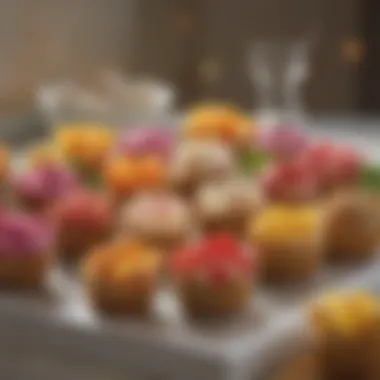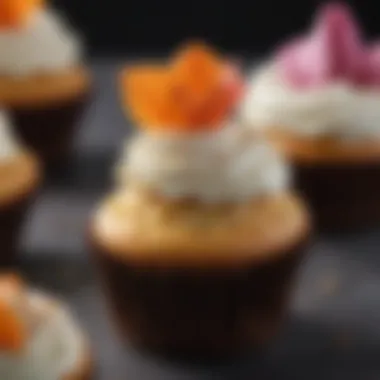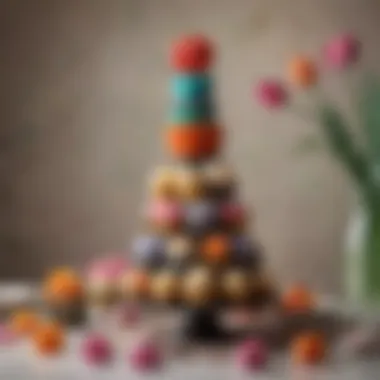Exploring the Elegance of Tulip Liners for Cupcakes


Intro
Tulip liners have become an essential component in the art of cupcake baking. Their stylish design goes beyond mere aesthetics, providing practical advantages that can enhance the entire baking experience. Understanding the unique characteristics of tulip liners allows both amateur and professional bakers to elevate their creations. This article will explore various aspects, highlighting why they have surged in popularity among culinary enthusiasts.
The focus will be on the unique design of tulip liners, differentiating them from traditional cupcake liners. In addition to their aesthetic appeal, their construction contributes to effective baking results and flavor retention. We will examine the available types, delve into best practices for use, and provide insight into how these liners can enhance texture and presentation.
As the discussion unfolds, it will not only serve as a guide for selecting the right tulip liner but also include tips for maintaining and applying them properly. Ultimately, this comprehensive exploration aims to enrich the baking repertoire of food lovers of all ages.
Intro to Tulip Liners
Understanding tulip liners is essential for anyone who bakes cupcakes, whether at home or in a professional setting. These unique liners shift the traditional cupcake aesthetic, providing a more gourmet look while enhancing baking performance. Tulip liners offer various advantages, such as improved heat distribution and a distinctive shape that allows for larger cupcakes. This section delves into their definition, historical context, and relevance, setting the stage for a deeper exploration of their types and advantages.
Definition and Overview
Tulip liners are specialized baking cups made primarily from parchment paper or silicone that are designed to resemble the shape of a tulip flower when filled with batter. This shape expands upwards, creating a generous and visually appealing presentation. Unlike standard cupcake liners, tulip liners often rise well beyond the rim of the baking pan, giving cupcakes a professional look.
They come in various sizes and colors, allowing bakers to express creativity. Their unique design provides not only aesthetic appeal but also functionality, such as enhancing moisture retention and flavor during the baking process. Additionally, tulip liners can make handling and serving cupcakes easier, as they provide a stable base.
History and Evolution
The use of liners in baking has a long history, traditionally focused on functionality rather than presentation. However, the evolution of tulip liners signifies a shift towards combining aesthetics with practicality. The origin can be traced back to Europe, where bakers sought ways to showcase their creations more appealingly. Over the years, creative designs emerged, leading to today’s tulip liners, which not only support baking performance but also serve as a decorative element.
With the rise of social media and a greater emphasis on food presentation, tulip liners gained popularity among bakeries and home bakers alike. They are synonymous with artisan cupcakes and have become a staple in many professional environments. The demand has led manufacturers to innovate, creating various materials and designs tailored to satisfy the preferences of diverse bakers. Overall, the development and adaptation of tulip liners reflect a broader trend in the culinary world towards elevating the entire baking experience.
Types of Tulip Liners
Understanding the types of tulip liners is crucial when it comes to baking cupcakes. Each type offers distinct advantages that can significantly enhance the baking experience and the final product. The decision on which type to use can influence not only the aesthetics but also the taste and texture of the cupcake. Here, we will delve into the three primary types of tulip liners: paper, silicone, and custom printed liners. Each has unique properties that cater to different preferences and baking needs.
Paper Tulip Liners
Paper tulip liners are perhaps the most common choice among bakers. They are versatile and often made from high-quality, food-safe paper. These liners come in various colors, patterns, and sizes, making them an attractive option for both home bakers and professionals.
One notable advantage of paper tulip liners is their ability to absorb excess moisture during baking. This helps create a drier outside texture while retaining moisture inside, leading to a perfectly baked cupcake. They are also disposable, which makes cleanup easy.
However, not all paper liners are created equal. Opting for grease-proof or non-stick options can enhance performance. Without this, some liners might stick to the baked cupcake, leading to a messy presentation.
Silicone Tulip Liners
Silicone tulip liners provide a different approach and offer several advantages over traditional paper liners. Made from high-quality silicone, these liners are reusable and can withstand high baking temperatures without warping or affecting the baked goods' flavor. They are typically flexible, allowing for easy removal of the baked cupcakes.
One of the biggest benefits of silicone tulip liners is their non-stick properties. This helps maintain the cupcakes' shape and reduces the likelihood of tearing the delicate liners. They are also dishwasher-safe, making maintenance simple and efficient.
On the downside, silicone liners can have a more limited aesthetic appeal compared to their paper counterparts. They are often available in fewer variations in design and color. Despite this, they are gaining popularity among culinary enthusiasts who prioritize functionality and sustainability in their baking endeavors.
Custom Printed Tulip Liners
Custom printed tulip liners take personalization to the next level. These liners can feature specific designs, logos, or messages, making them an excellent choice for professional bakeries or special events. Companies or individuals can create unique idenities through these customized choices, enhancing branding efforts while also making a memorable presentation.
From an operational standpoint, custom printed liners can be made from either paper or silicone materials. Both materials allow for practical use while showcasing distinctive designs. This versatility makes them both functional and appealing to a wide audience.
However, custom printed liners often require minimum order quantities, which means they may not be suitable for small-scale bakers or those just starting out. The cost factor is also a consideration worth noting, as bespoke liners can sometimes come at a premium.


Custom printed tulip liners allow bakers to create a unique identity for their products. This can significantly enhance branding and customer experience.
In summary, choosing the right type of tulip liner can impact both the baking process and the presentation of cupcakes. bakers should consider their specific needs, the desired aesthetic, and practicality while selecting their liners.
Advantages of Tulip Liners
The advantages of tulip liners extend beyond mere aesthetics; they incorporate crucial elements that make them an indespensable item for cupcake bakers. Understanding these benefits can enhance baking practices, boost presentation, and improve overall experience for both home bakers and professionals.
Aesthetic Appeal
Tulip liners stand out for their unique design. They have a distinctive shape that helps showcase cupcakes beautifully. Unlike traditional flat liners, these envelop the cupcake more luxuriously. When displayed, the natural curves of the tulip liner add a sophisticated touch. This appeal is especially valuable in contexts like birthdays or weddings, where visual presentation is as important as taste.
Some bakers choose vibrant colors and patterns to match themes, creating an attractive visual impact. Choosing the right tulip liner can elevate the product, enticing customers even before the first bite. The use of tulip liners communicates a commitment to quality and craftsmanship in baking.
Enhanced Baking Performance
Tulip liners, constructed from quality materials, contribute significantly to even baking. Unlike standard cupcake liners, they provide better heat distribution. This allows heat to reach the cupcake uniformly, reducing the risk of undercooking or burnt edges. As a result, bakers can achieve a perfect texture, closely aligned with their intended outcome.
Also, they offer a firmer structure. This firmness prevents collapsing during the batter pouring process, giving bakers more confidence in their technique. Their design supports the cupcake as it rises in the oven. Thus, bakers can focus on achieving that ideal rise and texture.
Flavor Retention and Moisture Control
One of the significant benefits of using tulip liners is their ability to retain flavors and moisture. These liners are typically more effective at keeping the cupcake's moisture intact, which is essential for maintaining taste and texture. When comparing them to standard liners, bakers often find that cupcakes in tulip liners stay fresher for longer.
Moreover, the materials used in tulip liners can sometimes enhance the flavor experience. They can provide a barrier that keeps ingredients from losing their integrity during baking. Thus, flavors remain vibrant, contributing to a more enjoyable eating experience. This quality is crucial for those who experiment with unique flavor combinations and seek to preserve their creations authentically.
"Choosing tulip liners can elevate your baking game, providing not just aesthetics but also performance benefits."
By understanding these advantages, bakers can make informed decisions, enhancing their craft while ensuring a pleasing presentation and delightful taste.
How to Use Tulip Liners Effectively
Using tulip liners correctly is essential for both aesthetic appeal and baking performance. Unlike traditional cupcake liners, tulip liners are designed to provide a unique look and enhance the baking process. This section will break down the steps to effectively use these versatile baking essentials, covering batter preparation, proper filling techniques, and best practices for baking and cooling.
Preparing Your Batter
Before you can fill tulip liners, proper batter preparation is crucial. The batter should be mixed well to ensure an even texture. Common ingredients for cupcake batter include flour, sugar, eggs, and butter. When incorporating these ingredients, it is important to follow the recipe closely to achieve the right consistency.
- Measure Ingredients Accurately: The first step is to measure your ingredients. Inaccurate measurements may lead to improper batter consistency and affect the final product.
- Mixing Techniques: When mixing the batter, use a stand mixer or hand mixer. Ensure all ingredients are fully combined but avoid overmixing, which can create toughness in the cupcakes.
The goal is to achieve a smooth batter that will rise well in the oven and maintain its shape. If desired, consider adding flavorings or mix-ins to the batter for extra dimension.
Filling the Liners Properly
Filling tulip liners may seem straightforward, but certain techniques can enhance both the look and taste of your cupcakes. Here are important aspects to consider:
- Do Not Overfill: Tulip liners can hold quite a bit of batter, but overfilling can lead to messy, overflowed cupcakes. Aim to fill the liners about two-thirds full. This allows for proper rising without spilling over.
- Use a Dispenser or Piping Bag: Utilizing a batter dispenser or piping bag can make filling the liners cleaner and more precise. This method helps in avoiding excess batter on the edges of the liners.
- Consider Layering Flavors: If including different flavors or colors, consider layering them in the liners to create a visually appealing effect. This method can make your cupcakes look unique and enhances the taste experience.
Baking and Cooling Techniques
Baking and cooling your cupcakes correctly is vital to achieving the best results when using tulip liners.


- Preheat the Oven: Always preheat your oven to the recommended temperature. This ensures that your cupcakes bake evenly from the start.
- Monitor Baking Time: Keep an eye on the baking time. Use a toothpick inserted in the center to test for doneness. If it comes out clean, the cupcakes are ready.
- Cooling Period: Once out of the oven, allow the cupcakes to cool in the pan for about 5-10 minutes, then transfer them to a wire rack. This prevents them from becoming soggy and helps maintain their sturdy shape.
Tip: Cooling the cupcakes completely before frosting is essential. This helps the frosting maintain its integrity and prevents it from melting.
Each step of the process, from preparing your batter to cooling, impacts the final product. By following these pointers, you can maximize the benefits of tulip liners while achieving delicious and beautiful cupcakes.
Choosing the Right Tulip Liners
Selecting the right tulip liners is crucial for achieving the desired results in your cupcake baking endeavors. The choice affects both the presentation and the baking process. With various options available, understanding specific elements can greatly enhance your baking experience. In this section, we will explore two important aspects: material selection and size and shape considerations.
Material Selection
The material of tulip liners plays a direct role in their effectiveness and functionality. Common materials used include paper and silicone, each offering distinct advantages.
- Paper Tulip Liners: These liners are often made from food-safe parchment paper. They are disposable and convenient. They provide good insulation, helping to maintain even baking and moisture retention. The designs are typically quite attractive, which enhances the visual appeal of the cupcakes.
- Silicone Tulip Liners: Silicone liners are reusable, making them an eco-friendlier option. They often provide a non-stick surface, allowing for easy cupcake removal. Their flexibility also means they can hold various shapes, adapting to different baking scenarios.
When choosing your material, consider both the environmental impact and the specific baking needs you have. For instance, if you bake frequently and prioritize sustainability, silicone liners may be the better choice.
Size and Shape Considerations
The size and shape of tulip liners are paramount for ensuring that your cupcakes come out perfectly. Different recipes may require different sizes to accommodate the batter volume.
- Standard Sizes: Most tulip liners come in standard cupcake sizes, fitting regular muffin trays perfectly. These are ideal for traditional-sized cupcakes.
- Mini and Jumbo Options: If you prefer mini or jumbo cupcakes, look for appropriately sized tulip liners. Mini liners are great for bite-sized treats, while jumbo liners work best for larger portions.
The shape is another consideration. Tulip liners generally features a unique shape that opens up, creating a ruffled effect once baked. This not only adds elegance but also allows for easy filling. When selecting your liners, consider the presentation style you want to achieve.
"Choosing the appropriate tulip liner enhances both the appearance and baking performance of cupcakes."
Ensuring proper material and size will ultimately lead to better baking outcomes. The decision on which tulip liners to use should align with your overall baking goals, particularly in aesthetics and usability.
Common Mistakes to Avoid
Using tulip liners can elevate the presentation of cupcakes, but there are common pitfalls that can undermine a baker's efforts. Recognizing these mistakes is crucial. Each error can affect not only the aesthetics but also the overall quality of the baked goods. By discussing these common missteps, bakers can improve their techniques and enjoy better results.
Overfilling the Liners
One of the most frequent errors bakers make is overfilling tulip liners. While it may seem tempting to maximize the batter in each liner for a tall cupcake, this approach often backfires. When liners are filled beyond capacity, batter spills over during baking. This leads to messy, irregular shapes which detract from the aesthetic appeal of the cupcakes.
Moreover, overfilling disrupts even baking. When too much batter is used, the center may not cook thoroughly while the edges become overcooked, yielding an unsatisfactory texture. To maintain a favorable outcome, it’s advisable to fill the liners only about two-thirds full. This allows adequate space for rising and helps achieve a uniform bake across all cupcakes.
Using Incorrect Baking Times
Timing is critical when baking with tulip liners. Every oven is different, and each recipe may vary, making the use of incorrect baking times a likely mistake. Not paying attention to the specific duration for which to bake can result in undercooked or overcooked cupcakes.
It's essential to rely not only on timers but also on visual cues. For instance, cupcakes are generally done when they spring back to touch and have a light golden color on top. A toothpick test can also be used. Inserting a toothpick into the center should yield a few moist crumbs, not wet batter. This strategy prevents common issues, ensuring the cupcakes maintain optimal texture and flavor.
Understanding these mistakes—overfilling and incorrect baking times—can significantly boost the quality and presentation of cupcakes made with tulip liners. Avoiding these missteps ensures not only a more appealing look but also a more enjoyable eating experience.
Tulip Liners in Professional Baking
Tulip liners play a crucial role in professional baking. Their design not only enhances aesthetic appeal but also influences baking outcomes. Many bakeries adopt tulip liners because they provide a distinctly elegant presentation compared to standard liners. This visual element can significantly attract customers and enhance sales. Additionally, the unique shape of tulip liners allows for a larger volume of batter, which can lead to taller cupcakes, offering a more inviting appearance.


In commercial settings, consistency is key. Tulip liners help achieve uniformity in cupcake size and shape. This consistency is vital for bakeries aiming to establish a reliable brand identity. Moreover, these liners offer practicality, as they tend to hold the batter well during baking, preventing overflow and mess. The sturdiness of tulip liners also means they can withstand handling, which is important when preparing cupcakes for display or transport.
Application in Bakeries
Many professional bakeries employ tulip liners for their effectiveness in both cooking and presentation. Bakeries utilize these liners to create a strong first impression, which is essential in competitive markets. They enhance profits by making products visually appealing, making customers more likely to purchase.
The application of tulip liners can vary among bakeries. Some use them exclusively for specific types of cupcakes or during seasonal events, while others may consistently deploy them for all their offerings. The use of high-quality paper or silicone can also affect both taste and texture, which is important in meeting customer expectations.
Trends in Commercial Cupcake Aesthetics
In the realm of commercial cupcake aesthetics, there has been a growing trend towards personalized and creative presentations. Tulip liners are seen as a part of this trend, marrying functionality with sophistication. The shape and style of these liners allow for various design possibilities, enabling bakeries to experiment with colors, patterns, and even branding directly on the liners.
The exploration of custom printed tulip liners is particularly noteworthy. Bakeries are now taking advantage of the opportunity to include logos or themed designs on their liners, which adds an extra marketing dimension. Such customizations not only increase brand recognition but also enhance customer experience.
As consumer preferences evolve, bakeries are also focusing on eco-friendly options. The rise in demand for sustainable packaging has led to the development of biodegradable tulip liners. These options align with consumer values, contributing positively to environmental efforts while maintaining the aesthetic appeal that tulip liners offer.
Choosing tulip liners effectively involves understanding market trends and consumer preferences, which can significantly enhance the overall quality of pastries in a bakery.
In summary, tulip liners have become integral to professional baking. Their contribution to aesthetics, adaptability, and efficiency aligns with the pursuit of high-quality baking standards in today’s culinary landscape.
Nutritional Aspects of Cupcakes with Tulip Liners
When considering the whole process of baking, the nutritional aspect often plays a critical role but is sometimes overlooked. The unique design of tulip liners not only elevates the visual appeal of cupcakes, but they can also have a significant impact on the overall baking process and the healthiness of the end product. Understanding these aspects is essential for anyone who aims to craft delightful yet nutritious cupcakes.
Ingredients that Work Best
The choice of ingredients is paramount for improving the nutritional profile of cupcakes baked in tulip liners. It is beneficial to use high-quality flour, such as whole wheat or almond flour, which are richer in nutrients compared to all-purpose flour. Natural sweeteners like honey or maple syrup can replace refined sugar, offering better flavor and additional vitamins. Incorporating fruits can also enhance nutrition; for example, mashed bananas or pureed apples can add moisture while reducing added fats. Additionally, using nut butters instead of oil can raise the protein content and provide flavor depth. Here are some ingredients to consider:
- Whole wheat flour or almond flour
- Natural sweeteners like honey or maple syrup
- Fruits such as bananas or apples
- Nut butters for added protein
- Greek yogurt for moisture and protein
Employing these ingredients not only optimizes the health factor but also works well with the tulip liners, preserving the moisture and flavors during the baking process.
Dietary Considerations
When preparing cupcakes, it is crucial to keep dietary needs in mind. For instance, incorporating gluten-free alternatives such as rice flour or coconut flour can cater to individuals with gluten intolerance. Awareness of food allergies, particularly to nuts or dairy, is also imperative. You might consider substituting cow's milk with almond or oat milk to serve a wider audience. Adding low-calorie and sugar-free options can appeal to health-conscious consumers.
“Dietary considerations allow bakers to innovate and personalize their recipes, creating options that cater to various health needs.”
In summary, the nutritional aspects of cupcakes made with tulip liners offer bakers the opportunity to create more wholesome treats. By selecting the right ingredients and considering dietary restrictions, individuals can make cupcakes that are not only visually appealing but also healthy without sacrificing taste.
End
The conclusion of this article serves as a pivotal point to reflect on the various insights gathered about tulip liners for cupcakes. These liners are not just aesthetic choices but practical tools that enhance the entire baking experience. We have discussed their design, types, and advantages, highlighting how they elevate both presentation and flavor retention in baked goods. Understanding these elements consolidates the value of employing tulip liners, as they not only make the cupcakes visually appealing but also contribute to optimal baking results.
One of the significant benefits of tulip liners is their adaptability, which allows bakers to experiment with different styles and recipes. They serve as a bridge between home baking and professional presentation, making them ideal for various occasions—from casual gatherings to elaborate events. Overall, embracing tulip liners allows culinary enthusiasts to elevate their creations while ensuring that taste and quality are never compromised.
Recap of Key Points
- Definition and Purpose: Tulip liners provide a distinctive flair to cupcakes while offering superior baking performance.
- Types of Liners: There are various types of tulip liners available, including paper, silicone, and custom printed options, catering to diverse baking needs.
- Advantages: Their aesthetic appeal, combined with enhanced baking performance, makes them a preferred choice for many bakers.
- Usage Tips: Proper preparation, filling techniques, and baking methods are critical for achieving optimal results with tulip liners.
- Nutritional Aspects: Understanding how different ingredients interact with tulip liners can impact the overall outcome and flavor retention.
- Professional Application: Tulip liners play a crucial role in commercial cupcake aesthetics, reflecting current trends in baking.
Future Trends in Cupcake Design
As the culinary landscape continues to evolve, we can anticipate several trends that will shape the future of cupcake design with tulip liners. One significant trend is the growing interest in eco-friendly materials. As consumers become more environmentally conscious, the demand for biodegradable and recyclable pastry liners is likely to increase.
Another trend is the personalization of cupcakes. Custom printed tulip liners are paving the way for unique branding opportunities in bakeries and businesses. Offering diverse designs that cater to individual preferences will likely gain traction.
Moreover, flavors and fillings infused with innovative ingredients will also drive the cupcake industry. As bakers experiment with healthier alternatives and exotic flavor profiles, tulip liners can protect and enhance these new taste experiences while maintaining presentation.
Embracing these trends will be key for anyone looking to stay relevant in the evolving cupcake market. Tulip liners will remain a pivotal element, merging functionality with creativity as they adapt to new consumer preferences and sustainability efforts.







